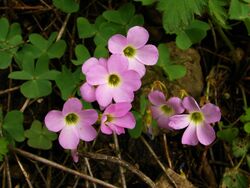Biology:Oxalis violacea
| Oxalis violacea | |
|---|---|

| |
| Scientific classification | |
| Kingdom: | Plantae |
| Clade: | Tracheophytes |
| Clade: | Angiosperms |
| Clade: | Eudicots |
| Clade: | Rosids |
| Order: | Oxalidales |
| Family: | Oxalidaceae |
| Genus: | Oxalis |
| Species: | O. violacea
|
| Binomial name | |
| Oxalis violacea | |
| Synonyms | |
| |
Oxalis violacea, the violet wood-sorrel, is a perennial plant and herb in the family Oxalidaceae.[1] It is native to the eastern and central United States.
Description
Oxalis violacea emerges in early spring from an underground bulb and produces leaf stems 7–13 cm (2 3⁄4–5 in) tall and flower umbels, or clusters, with up to 19 flowers on stems 9–23 cm (3 1⁄2–9 in) tall.[2] The three-part leaves have heart-shaped leaflets. The plant is similar in appearance to small clovers such as the shamrock.
The plant bears lavender to white flowers 1–2 cm (1⁄2–3⁄4 in) wide with white to pale green centers above the foliage, during April or May, rarely to July, and, with rain, sometimes produces additional flowers without leaves from August to October.[2]
Etymology
The genus name, Oxalis, is from the Greek word oxys, which means "sharp" and refers to the sharp or sour taste from the oxalic acid present in the plant.[3][4] The specific epithet, violacea, is Latin for violet-colored.[5]
Distribution and habitat
It is native plant in much of the United States , from the Rocky Mountains east to the Atlantic Ocean and Gulf of Mexico coasts, and through Eastern Canada. It has a tendency to cluster in open places in damp woods and on stream banks, and in moist prairies.[1]
Conservation
The plant's conservation status is globally secure;[6] however, it is listed as endangered in Massachusetts[7] and Rhode Island,[8] threatened in New York,[9] and a species of special concern in Connecticut.[10] It is presumed extirpated in Michigan.[11]
Uses
Medicinal
Oxalis violacea was used as a medicinal plant by Native Americans, including the Cherokee and Pawnee peoples.[12]
Culinary
All parts of the plant are edible – flowers, leaves, stems, and bulb. Oxalis is from the Greek word meaning sour, and this plant has a sour juice. It is used in salads. Moderate use of plant is advisable, as it should not be eaten in large quantities due to a high concentration of oxalic acid, ("salt of lemons") which can be poisonous.[13]
It was a traditional food source of the Native American Apache, Cherokee, Omaha, Pawnee, and Ponca peoples.[12]
Cultivation
Oxalis violacea is cultivated as an ornamental plant, for use as a flowering groundcover or perennial plant in traditional and native plant gardens, and for natural landscaping projects.[14] It spreads rapidly by runners and bulbs.[15] In gardens the plant prefers partial shade and moisture.[15]
References
- ↑ 1.0 1.1 {{citation | mode = cs1 | title = Oxalis violacea | work = Germplasm Resources Information Network (GRIN) | url = | publisher = [[Organization:Agricultural Research ServAgricultural Research Service (ARS), United States Department of Agriculture (USDA) | access-date = 21 January 2018 }}
- ↑ 2.0 2.1 Nesom, Guy L. (2016), "Oxalis violacea", in Flora of North America Editorial Committee, Flora of North America North of Mexico (FNA), 12, New York and Oxford, http://www.efloras.org/florataxon.aspx?flora_id=1&taxon_id=
- ↑ "oxalis - WordReference.com Dictionary of English" (in en). https://www.wordreference.com/definition/oxalis.
- ↑ Denison, Edgar (2017). Missouri Wildflowers (Sixth ed.). Conservation Commission of the State of Missouri. pp. 58. ISBN 978-1-887247-59-7.
- ↑ "Latin Definition for: violaceus, violacea, violaceum (ID: 38867) - Latin Dictionary and Grammar Resources - Latdict". https://latin-dictionary.net/definition/38867/violaceus-violacea-violaceum.
- ↑ "NatureServe Explorer 2.0". https://explorer.natureserve.org/Taxon/ELEMENT_GLOBAL.2.158359/Oxalis_violacea.
- ↑ "List of Endangered, Threatened, and Special Concern species | Mass.gov" (in en). https://www.mass.gov/info-details/list-of-endangered-threatened-and-special-concern-species#plants.
- ↑ "Oxalis violacea (violet wood sorrel): Go Botany". https://gobotany.nativeplanttrust.org/species/oxalis/violacea/.
- ↑ "Violet Wood Sorrel Guide - New York Natural Heritage Program". https://guides.nynhp.org/violet-wood-sorrel/#:~:text=In%20New%20York%20Oxalis%20violacea,York%20Natural%20Heritage%20Program%202007)..
- ↑ "Oxalis violacea". https://www.ct-botanical-society.org/plants/Plants/view/423.
- ↑ "Oxalis violacea (Violet wood sorrel) - Michigan Natural Features Inventory". https://mnfi.anr.msu.edu/species/description/14490/Oxalis-violacea.
- ↑ 12.0 12.1 "BRIT - Native American Ethnobotany Database". http://naeb.brit.org/uses/search/?string=oxalis+violacea.
- ↑ Berglund, Berndt; Bolsby, Clare E. (1971). The Edible Wild: A complete cookbook and guide to edible wild plants in Canada and North America. Burns & MacEachern Limited—Pagurian Press Limited..
- ↑ "Oxalis violacea". Plant Finder. Missouri Botanical Garden, Kemper Center for Home Gardening. http://www.missouribotanicalgarden.org/PlantFinder/PlantFinderDetails.aspx?kempercode=l340.
- ↑ 15.0 15.1 Oxalis violacea, Lady Bird Johnson Wildflower Center, University of Texas at Austin, http://www.wildflower.org/plants/result.php?id_plant=OXVI
- Blanchan, Neltje (2005). Wild Flowers Worth Knowing. Project Gutenberg Literary Archive Foundation.
External links
Wikidata ☰ Q1067933 entry
 |


